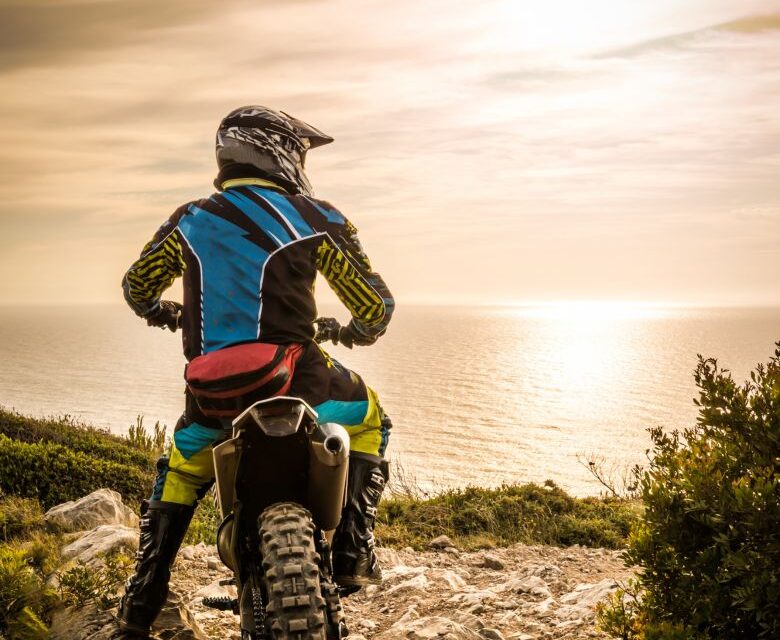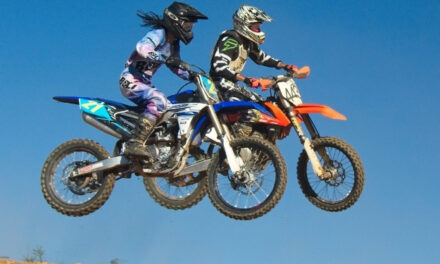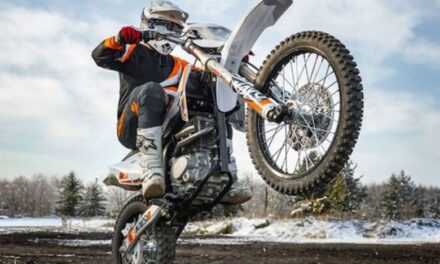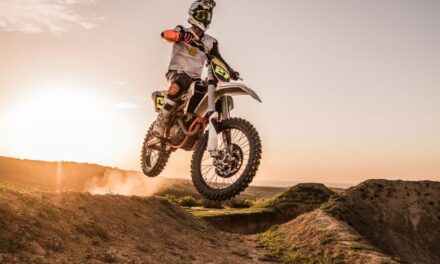Finding the perfect mountain bike heavy rider can be a challenging yet rewarding journey. Whether you’re tackling rugged trails or cruising through forest paths, having the right bike that supports your weight without compromising performance is essential. Heavy riders often face unique challenges, such as increased stress on the frame, tires, and suspension, which can lead to faster wear and tear. However, with advancements in bike technology, there are now plenty of options designed to offer both durability and comfort, catering specifically to the needs of heavier cyclists.
Choosing the right mountain bike isn’t just about finding one that fits—it’s about finding one that enhances your riding experience, providing stability, control, and confidence on every ride. From reinforced frames to wider tires and robust suspensions, the best mountain bikes for heavy riders are built to withstand greater demands while ensuring a smooth and enjoyable ride.
This guide will help you navigate the essential features to look for and recommend some top picks that combine strength, reliability, and performance, empowering you to hit the trails with confidence.
Rugged Rides: The Best Mountain Bike Heavy Rider
In this comprehensive guide, we’ll explore the best mountain bikes specifically tailored for heavy riders, covering everything from key features to consider, top bike recommendations, and tips for maintenance and customization. For more information visit here
Table of Contents
Understanding the Needs of Heavy Riders
mountain bike heavy rider face unique challenges when it comes to mountain biking. The added weight can place significant stress on various components of the bike, including the frame, wheels, tires, suspension, and brakes. As a result, not all mountain bikes are created equal—especially when it comes to supporting higher weights.
Key Considerations:
- Frame Strength: The frame is the backbone of the mountain bike heavy rider. For heavy riders, opting for a bike with a strong, durable frame made from materials like steel or high-grade aluminum is essential. Carbon fiber frames, while lightweight, may not provide the necessary strength and durability.
- Wheel Size and Strength: Larger and more robust wheels are better suited to distribute the rider’s weight evenly. Bikes with 29-inch wheels are often recommended for heavy riders due to their increased stability and ability to handle rough terrain.
- Suspension: A good suspension system is vital for absorbing shocks and providing a comfortable ride. Heavy riders should look for bikes with strong and adjustable suspension systems, especially in the front fork and rear shocks.
- Braking Power: Strong brakes are essential for maintaining control, especially when descending steep trails. Hydraulic disc brakes are preferred for their consistent performance and better stopping power under heavy loads.
- Tire Width and Pressure: Wider tires with higher air volume are better suited to support extra weight, offering better traction and stability. Tubeless tires can also be beneficial, as they allow for lower pressure, reducing the risk of pinch flats.
Top Features to Look for in a mountain bike heavy rider
- Durable Frame Construction
- Material Matters: As mentioned, steel and aluminum frames are highly recommended for their durability. Steel is incredibly strong and can absorb vibrations well, though it tends to be heavier. Aluminum is lighter but still provides excellent strength and resistance to corrosion.
- Reinforced Joints: Look for mountain bike heavy rider with reinforced joints and welds. These are critical stress points that need to be strong enough to handle the additional weight.
- High-Quality Suspension System
- Adjustability: A suspension system that allows for adjustments based on weight and riding conditions is ideal. This ensures the bike can be fine-tuned for optimal performance.
- Air vs. Coil: While coil suspensions are robust and can handle more weight, air suspensions offer more adjustability and are lighter, which can be advantageous for heavy riders.
- Wider, Stronger Wheels
- Rim Strength: Double-walled rims provide additional strength and are better suited to handle the weight. Consider rims made from stronger alloys or even carbon fiber reinforced materials for added durability.
- Spoke Count: A higher spoke count (32 or 36 spokes per wheel) distributes weight more evenly and increases wheel strength.
- Powerful Brakes
- Hydraulic Disc Brakes: These are the gold standard for mountain bike heavy rider, especially for heavy riders. They provide superior stopping power and perform well in all weather conditions.
- Larger Rotors: Opt for bikes with larger brake rotors (180mm or more), as they offer better heat dissipation and more effective braking.
- Robust Tires
- Wide and Tubeless: Tires that are at least 2.3 inches wide are recommended. Tubeless setups allow for lower pressure, which increases comfort and traction while reducing the risk of flats.
- Tread Pattern: Depending on the terrain, choose tires with appropriate tread patterns for better grip and control.
Recommended Mountain Bikes for Heavy Riders
Here are some of the best mountain bikes that cater to the needs of mountain bike heavy rider:
- Diamondback Overdrive 29
- Frame: Aluminum
- Suspension: Front suspension with a SR Suntour XCT fork
- Wheels: 29-inch double-walled alloy rims
- Brakes: Hydraulic disc brakes
- Tires: 2.25-inch wide tires
- Trek Stache 7
- Frame: Alpha Platinum AluminumSuspension: Manitou Machete 34 fork with 120mm travelWheels: 29-inch tubeless-ready rimsBrakes: Shimano hydraulic disc brakesTires: 3.0-inch wide Bontrager XR2 Team Issue
- Santa Cruz Hightower
- Frame: Carbon C or CC Suspension: RockShox Super Deluxe Select rear shock, Fox 36 Float Performance Elite forkWheels: 29-inch with high-strength carbon rimsBrakes: SRAM Code RSC hydraulic disc brakesTires: Maxxis Minion DHF 2.5-inch wide tires
- Giant Trance X E+ Pro 29
- Frame: ALUXX SL-Grade Aluminum
- Suspension: Maestro suspension system with 150mm of travel
- Wheels: 29-inch tubeless-ready rims
- Brakes: Shimano BR-MT520 hydraulic disc brakes
- Tires: Maxxis Minion DHF 2.5-inch wide tires
- Norco Sight VLT C1
- Frame: Carbon
- Suspension: RockShox Super Deluxe Select + rear shock, RockShox Lyric Select+ fork
- Wheels: 29-inch tubeless-ready rims
- Brakes: Shimano XT hydraulic disc brakes
- Tires: Maxxis Minion DHF/DHR 2.5-inch wide tires
Customization and Upgrades for mountain bike heavy rider
Even with a top-of-the-line bike, you may want to consider some customizations or upgrades to better suit your needs:
- Upgrading Wheels: If the stock wheels aren’t strong enough, consider upgrading to stronger, reinforced wheels. Look for options with higher spoke counts and thicker rims.
- Seat and Seatpost: A wider, more comfortable saddle can make a big difference, especially on longer rides. Additionally, a dropper seatpost allows for easy adjustments on the fly, which is particularly useful on varied terrain.
- Pedals: Choose pedals that provide a large, stable platform. Flat pedals with aggressive pins can offer better grip, especially if you prefer to mountain bike heavy rider without clipless shoes.
Maintenance Tips for Heavy Riders
Regular maintenance is crucial for keeping your bike in top condition, especially when it’s subjected to additional stress. Here are some tips:
- Frequent Checks: Regularly inspect your bike for signs of wear and tear, especially on the frame, wheels, and suspension components.
- Tire Pressure: Maintain proper tire pressure, but be mindful not to overinflate. Tubeless setups can be run at lower pressures for better traction and comfort.
- Brake Pads: mountain bike heavy rider may wear through brake pads faster, so keep an eye on them and replace as needed to ensure consistent braking performance.
- Suspension Servicing: Given the extra load, your suspension will work harder. Regular servicing is essential to keep it performing optimally.
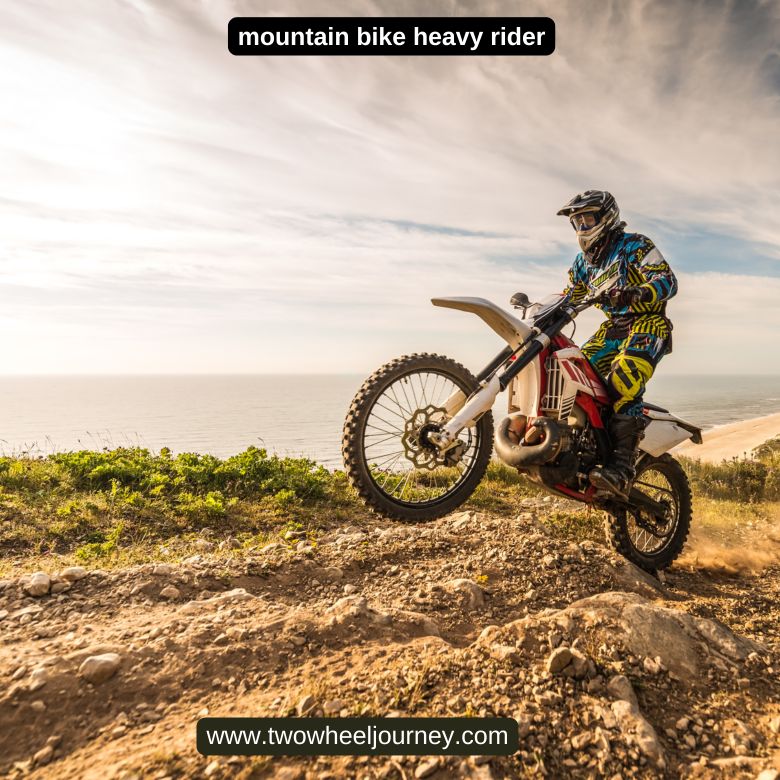
Advanced Tips for Heavy Riders: Enhancing Your Riding Experience
Beyond choosing the right mountain bike heavy rider and components, there are several advanced strategies and tips that can further improve your mountain biking experience as a heavy rider. These tips focus on improving your overall comfort, control, and performance on the trails.
Optimizing Your Riding Technique
Heavy riders can benefit from refining their riding technique to better manage the mountain bike heavy rider dynamics. Proper technique not only enhances control but also reduces stress on your bike’s components.
- Body Position: Maintaining a balanced and centered body position on the bike is crucial. When climbing, shift your weight slightly forward to keep the front wheel grounded. On descents, move your weight back to avoid going over the handlebars and to maintain stability.
- Cornering: Entering and exiting corners smoothly is essential.mountain bike heavy rider should focus on leaning the bike rather than their body to maintain traction and control. Practice braking before the turn and accelerating smoothly out of it.
- Braking Technique: Avoid grabbing the brakes too hard, which can lead to skidding or loss of control. Instead, apply the brakes smoothly and gradually. Distribute braking force between the front and rear brakes to maintain balance.
Selecting the Right Gear Ratios
Heavy riders may find it challenging to maintain momentum on steep climbs or rough terrain. Choosing the right gear ratios can make a significant difference in your ability to tackle various trail conditions.
- Low Gearing: A mountain bike heavy rider with a wide range of gears, especially lower gears, can make climbing easier. Look for a drivetrain with a large rear cassette (e.g., 11-50T) to provide a variety of low gear options.
- Chainring Size: Consider using a smaller chainring in the front to reduce the effort required when pedaling uphill. This can be particularly useful if you often ride on hilly or mountainous terrain.
Suspension Setup for Heavy Riders
Properly setting up your suspension is vital for achieving the best performance and comfort. mountain bike heavy rider should pay particular attention to suspension sag and damping adjustments.
- Suspension Sag: Adjust the suspension sag (the amount the suspension compresses under the rider’s weight) to match your weight. Aim for around 25-30% sag for most trail riding. This may require increasing air pressure or switching to stiffer springs.
- Compression Damping: mountain bike heavy rider may benefit from increasing the compression damping to prevent the suspension from bottoming out on rough terrain. This helps maintain control and prevents damage to the suspension.
- Rebound Damping: Adjust the rebound damping to control how quickly the suspension returns to its normal position after compressing. Too fast, and the bike may feel unstable; too slow, and the suspension may not be ready for the next obstacle.
Upgrading to Custom Components
If you’re looking to take your mountain biking to the next level, consider upgrading to custom components tailored to your needs as a mountain bike heavy rider.
- Custom Wheels: Custom-built wheels with higher spoke counts, thicker gauge spokes, and reinforced rims can provide additional strength and durability. Opting for high-quality hubs can also enhance the performance and longevity of your wheels.
- Suspension Upgrades: Consider upgrading to a suspension fork or rear shock that’s specifically designed for heavier mountain bike heavy rider. Some manufacturers offer options with stiffer springs or adjustable air chambers to accommodate more weight.
- Handlebars and Stems: Wider handlebars offer better leverage and control, which can be particularly beneficial for heavy riders. Pairing wider handlebars with a shorter stem can improve handling and stability.
Training and Fitness Considerations
While having the right equipment is crucial, improving your fitness and strength can also enhance your riding experience. Stronger muscles provide better support, reduce fatigue, and improve your overall control on the bike.
- Strength Training: Incorporate strength training exercises that focus on your legs, core, and upper body. Squats, lunges, and deadlifts are excellent for building leg strength, while planks and kettlebell swings help strengthen your core and upper body.
- Cardiovascular Fitness: Improving your cardiovascular fitness through activities like running, cycling, or swimming can enhance your endurance on long mountain bike heavy rider. This allows you to maintain a steady pace and tackle challenging trails without tiring quickly.
- Flexibility and Mobility: Incorporating flexibility and mobility exercises, such as yoga or dynamic stretching, can improve your range of motion and prevent injuries. This is especially important for heavy riders, as increased flexibility can help with body positioning and maneuverability on the mountain bike heavy rider.
Nutrition and Hydration
Proper nutrition and hydration are essential for maintaining energy levels and avoiding fatigue during rides, especially for heavy riders who may exert more energy.
- Balanced Diet: Focus on a balanced diet that includes a mix of carbohydrates, proteins, and healthy fats. Carbohydrates provide quick energy, while proteins aid in muscle recovery. Healthy fats help sustain energy levels during longer mountain bike heavy rider.
- Pre-Ride Nutrition: Consume a meal rich in carbohydrates and moderate in protein about 2-3 hours before your ride. This provides the energy needed to tackle the trails without feeling sluggish.
- Hydration: Stay hydrated by drinking water regularly throughout your ride. Consider using an electrolyte drink to replenish essential minerals lost through sweat, especially on hot days or during intense rides.
Riding with Confidence
Confidence plays a significant role in your overall riding experience. mountain bike heavy rider may feel self-conscious or uncertain, especially if they’re new to mountain biking. Building confidence takes time and practice, but it’s key to enjoying the sport.
- Start Small: Begin with easier trails and gradually work your way up to more challenging terrain. This allows you to build skills and confidence without feeling overwhelmed.
- Ride with Others: Join a group or find a riding partner who can offer encouragement and tips. Riding with others can make the experience more enjoyable and help you push your limits in a supportive environment.
- Celebrate Progress: Acknowledge your improvements, whether it’s conquering a challenging trail or improving your fitness. Celebrating small victories helps build confidence and motivates you to keep progressing.
To sum up
The joy of venturing into the vast outdoors combined with physical hurdles can make mountain biking an immensely fulfilling experience for mountain bike heavy rider. You can approach any route with confidence and really enjoy the ride if you have the right bike, are set up properly, and concentrate on technique.
Recall that the adventure, the freedom, and the sheer joy of riding a bike are the true attractions of mountain biking. Above all, enjoy yourself, accept the challenge, and be proud of your advancements. You can succeed in mountain biking with the correct bike and an optimistic outlook, regardless of your riding goals—fitness, adventure, or just the love of the sport. Many happ

